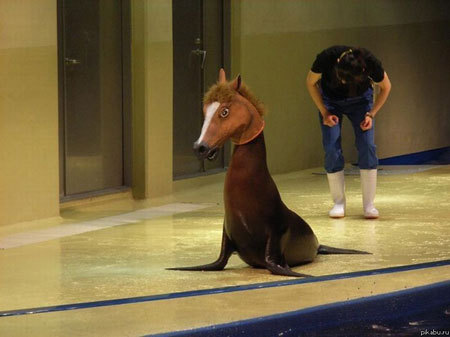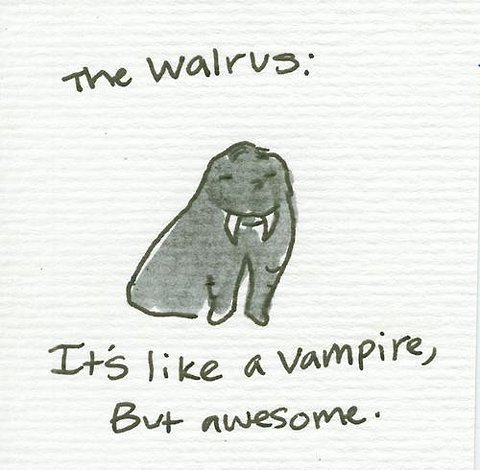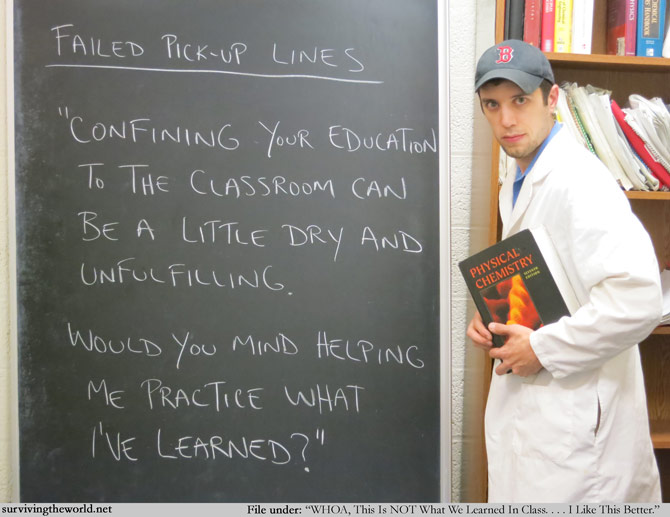It's crude, but if you could strip off all the distractions, like vegetation and soil, this is approximately what you would see in the neighborhood of the Cheshire Cat quarry. I'm thinking I may have the rubble a bit too low- that is, there's less of the hackly jointing visible under the columnar jointing than I've depicted, but that's okay: it doesn't really affect the interpretation here. I realized that the first photo in Dana's post fortuitously catches a bit of the contact between the basalt and the older, underlying altered rock- here's a direct link to that picture.
Also, you might want to check out the comments and my responses on Dana's post. In particular, this: "Yes, the flow *is* thicker in the middle. You’re getting awfully close,
but I have no reason to think this was affected/influenced by ice at the
time of eruption, and I’ve not seen any pillow basalt in this area.
However, I think you’re on the right track. There is a key place name
I’ve avoided mentioning in the clues so far, but it’s related to why I
brought up Boulder Creek for clue 7."
And for the sake of completeness, I'll add the age of the volcanics and volcaniclastics in the area is perhaps 30 +/-5 Ma, the age of alteration is about 18 Ma, and the age of this volcanic cone and flow is >2 Ma, but I don't know an absolute age.
So once again, what will we see when we cross the road and look down toward Canal Creek?
Miscellaneous thoughts on politics, people, math, science and other cool (if sometimes frustrating) stuff from somewhere near my favorite coffee shop.
Saturday, October 20, 2012
Saturd80's: Laurie Anderson Edition
Have I said recently how much I adore Laurie Anderson? 'Cause I do. All of these are from 1984's "Home of the Brave." This one's for you, Felix: "Gravity's Angel."
"Zero and One"
"Excellent Birds"
"Zero and One"
"Excellent Birds"
Cheshire Cat! Clue 7 and a Question
Clue 7: Boulder Creek, which is only a few miles away, has a smaller drainage basin than the stream draining the Quartzville town site area, and is a perennial stream- that is, it always has at least a small amount of water flowing in it, even during the driest summers. (If you click on the arrow on the upper right corner of that map, Canal Creek and the quarry will be in the upper right- NE- of the following map location)
Question: What does the shape and orientation of the columnar jointing in the "grin" tell you about the nature of the cooling surface of this flow?
Clue 8, which I'll try to get up between 5 and 6 PM PDT, will be a crude sketch of the bedrock units exposed along the cliff face in the neighborhood of the quarry, on the opposite side of the road from Canal Creek. Unfortunately, I didn't think to get any photos to illustrate the bedrock relationships here.
Addendum: Dana has a post linking the clues and puzzle, with some additional photos.
Question: What does the shape and orientation of the columnar jointing in the "grin" tell you about the nature of the cooling surface of this flow?
Clue 8, which I'll try to get up between 5 and 6 PM PDT, will be a crude sketch of the bedrock units exposed along the cliff face in the neighborhood of the quarry, on the opposite side of the road from Canal Creek. Unfortunately, I didn't think to get any photos to illustrate the bedrock relationships here.
Addendum: Dana has a post linking the clues and puzzle, with some additional photos.
Friday, October 19, 2012
Cheshire Cat! Clues 5 and 6
Okay, I just got my first comment on this puzzle, which I read too quickly before responding, and somewhat misinterpreted. Ron Schott wrote: "I'm gonna guess that the cinder cone that this lava flow emanated from
is what's across the road, and the quarry was mining it for
aggregate/road metal." Now I interpreted that to mean "The Cheshire Cat outcrop/quarry is a lava flow from the cinder cone," which is exactly the conclusion I was hoping someone might reach. My response to Ron was "So far, so good. That's my assumption too- though without dating both, I
can't say for sure. But it's consistent with everything I know and have
seen in the area. And in fact, the next clue, which I'm aiming to get
up before I leave, hopefully shortly, is to distinguish these two basalt
components from the older altered rock in the area. But the question
is, "What will we see when we cross the road from the quarry (other than
Canal Creek)?" I'm betting you're close enough to figuring out the
answer that if you look at some geographic names in the vicinity, you'll
get it, along with the sequence of events." In fact, one of the things you will see across the road is a bit more of this flow, on the other side of Canal Creek. So Ron was, in a manner of speaking, correct, but there's still another thing that you'll see, on the same side of Canal Creek, below the road.
However, the shape of the "smile" in the original mosaic should be telling you something...
Here's a photo from Lava Butte, in central Oregon, that I was planning to put up in a day or two, if no one had made the cinder cone/lava flow connection:
Looking up the gutter of a lava flow from a later eruptive stage than that which formed the cinder cone, at Lava Butte, Newberry Volcano National Monument, Oregon. We'll call that clue 5. And here's clue 6: remember, most of the rock in the Quartzville area widely has been hydrothermally altered to one degree or another, and in this immediate area, we're pretty much at the center of the mineralization- the older, altered rock consists almost entirely of cross-cutting quartz veins and breccias. This is tough stuff. There are some joints and faults, but even these have largely been re-cemented with quartz.
Vein quartz and crystals, near Red Heifer Pass, above Quartzville town site.
Roof (in quartz breccia) of the Snowstorm Tunnel, just uphill from the Quartzville town site.
And I'll toss in a couple reminders: look at the topo map of the area, and note names of features. (That link is framed a bit differently than the previous link in clue 3, and zoomed out by 2x- so it covers more of the general area.) Also, look over the road log, especially the stops after Yellowbottom, at mileage 22.0. If you do those things, the answer will be staring you in the face. I have a feeling if I have to post another clue, that one will be a dead give-away...
However, the shape of the "smile" in the original mosaic should be telling you something...
Here's a photo from Lava Butte, in central Oregon, that I was planning to put up in a day or two, if no one had made the cinder cone/lava flow connection:
Looking up the gutter of a lava flow from a later eruptive stage than that which formed the cinder cone, at Lava Butte, Newberry Volcano National Monument, Oregon. We'll call that clue 5. And here's clue 6: remember, most of the rock in the Quartzville area widely has been hydrothermally altered to one degree or another, and in this immediate area, we're pretty much at the center of the mineralization- the older, altered rock consists almost entirely of cross-cutting quartz veins and breccias. This is tough stuff. There are some joints and faults, but even these have largely been re-cemented with quartz.
Vein quartz and crystals, near Red Heifer Pass, above Quartzville town site.
Roof (in quartz breccia) of the Snowstorm Tunnel, just uphill from the Quartzville town site.
And I'll toss in a couple reminders: look at the topo map of the area, and note names of features. (That link is framed a bit differently than the previous link in clue 3, and zoomed out by 2x- so it covers more of the general area.) Also, look over the road log, especially the stops after Yellowbottom, at mileage 22.0. If you do those things, the answer will be staring you in the face. I have a feeling if I have to post another clue, that one will be a dead give-away...
Corvallis Geology Map
I have been informed by various geobloggers, notably and most delectably by Silver Fox, that today is geologic map day. So here's the geology of my little burg:
Mappable units include, from youngest to oldest,
Mappable units include, from youngest to oldest,
- Qtl- Quaternary terrace, low (Willamette gravels and other sediments)
- Qtm- Quaternary terrace, mid-level
- Qth- Quaternary terrace, high
- Ti- Tertiary intrusive (Mafic, mostly diabasic in texture)
- Ts- Spencer Formation (near-shore marine deposits)
- Tf- Now classified as Tyee, turbidite deposits called Flournoy Formation at the time.
- Tsr- Siletz River Volcanics
- The Corvallis Fault has uplifted older Tsr with respect to younger sedimentary units along the slash from upper right to lower middle
- Pediments are identified by diagonal cross-hatching
- Areas of particularly high slope (and thus high mass movement risk) are identified with dark gray shading
Cheshire Cat! Clue 4
Dana standing in front of cinder cone deposits at mile 24.2 on the Quartzville trip. This was an extremely hot day, and the highly permeable nature of this pile of cinders means that air moves into the upper portion of the hill, cools as it comes in contact with the rock, then "drains" out near the base. I've never taken a thermometer to actually measure the air temperature near some of these vents, but there is a noticeable breeze, and I'd estimate it's in the mid 50's... very nice on a hot summer day! Natural air conditioning.
Another vent in the cinders. These two photos are in the spot labeled "Gravel Pit" near the center of this topo map crop. You now have three explicit clues to what's on the other side of the road from the Cheshire Cat outcrop, one veiled, and a couple I've dropped but not mentioned yet...
I'll post another later this afternoon, and given that I haven't even got a nibble on this yet, I'll mention I'd be happy to answer any questions that don't involve clues I'm planning on posting in the future.
Another vent in the cinders. These two photos are in the spot labeled "Gravel Pit" near the center of this topo map crop. You now have three explicit clues to what's on the other side of the road from the Cheshire Cat outcrop, one veiled, and a couple I've dropped but not mentioned yet...
I'll post another later this afternoon, and given that I haven't even got a nibble on this yet, I'll mention I'd be happy to answer any questions that don't involve clues I'm planning on posting in the future.
Thursday, October 18, 2012
Cheshire Cat! Clue 3 for the Puzzle
Following on with the puzzle from yesterday, here's a view from near the stop at mile 24.2 in the road log- actually, a tenth of a mile or so beyond that, looking over a recent clear cut. Here's the approximate Flash Earth location of where the photo was taken. Dry Gulch is about a tenth of a mile to the right (~E) of where the photo was taken. We're looking from cinder cone deposits pretty much NW toward Canal Creek, along which the Cheshire Cat outcrop resides. Note the denuded flat platform in the midground is quite unlike the incised, rugged peaks that make up the bulk of this landscape.
Actually, here's a better way to see it- a zoom into the USGS 1:62500 quad topo map of the area. The stop at mileage 24.2 is the spot labeled "gravel pit" near the center of the map (It clearly was a gravel pit when I started visiting the area, but it's overgrown now, and that's not so obvious.), and the Cheshire Cat outcrop is in the spot marked "quarry" just to the SE of the bold "Canal" label- the rest of the label, "Creek," is cut out in this crop, though visible in the FE links. The topo map view really helps emphasize how this odd bit of landscape is quite different from its surroundings..
Also, did you figure out what the second clue was, yet?
Actually, here's a better way to see it- a zoom into the USGS 1:62500 quad topo map of the area. The stop at mileage 24.2 is the spot labeled "gravel pit" near the center of the map (It clearly was a gravel pit when I started visiting the area, but it's overgrown now, and that's not so obvious.), and the Cheshire Cat outcrop is in the spot marked "quarry" just to the SE of the bold "Canal" label- the rest of the label, "Creek," is cut out in this crop, though visible in the FE links. The topo map view really helps emphasize how this odd bit of landscape is quite different from its surroundings..
Also, did you figure out what the second clue was, yet?
Wednesday, October 17, 2012
Smile If you Like Earth Science Week: Cheshire Cat!
"Well! I've often seen a cat without a grin,' thought Alice; 'but a
grin without a cat! It's the most curious thing I ever saw in my life!'" -Lewis Caroll, Alice's Adventures in Wonderland
Above is the first panorama I've ever tried to create, using Hugin. It's by no means a work of art, but I think it does a good job of showing an old quarry I've referred to as "The Cheshire Cat Outcrop" for, well, over 25 years now. You can click to embiggen, or open in a new tab with a right click. Alders have come up between the road and this wall, creating a nice, cool shady spot. On the positive side, the alders are now tall enough, and clear enough underneath, that you can see this spot from the road if you're looking for it- it went through a period of a decade or so where getting in to see the wall was a real pain. The FlashEarth location is here (approximately).
There is a fine puzzle that I always presented to Middle School-aged students at this spot, which as far as I can remember, they eventually got every time- with chains of leading questions and reminders of recent stops. It required understanding the implications of what they'd seen in the general area so far (this was normally the last stop of the Quartzville trip), the processes acting in the past and present in the area, and an ability to project this 2-dimensional wall into a 3rd dimension. You have two clues so far- the photo and another I won't draw your attention to directly- but the puzzle is this: ""What will we see when we cross the road?"
There are more clues in the Quartzville Road Log (last mileage at 34.5, and this outcrop 0.1 mi back toward Quartzville Creek), and I'll be posting more clues in coming days. A full answer should include a sequence of events- though not ages, necessarily- as well as identifying the feature on the other side of the road. Good Luck!
Followup, Oct. 18: Clue 3
Followup, Oct 19 AM: Clue 4
Followup, Oct 19 PM: Clues 5 and 6
Followup, Oct 20 noonish: Clue 7 and a Question
Followup, Oct 20 PM: A Sketch of the Quarry Area
Followup, Oct 21: About Clue 2...
Followup, Oct 21: We Can Haz A Winner!
Followup, Oct 21: The Whole Story
Tuesday, October 16, 2012
A Short Earth Science Week Photo Post: Splort!
Last summer, August 20, 2011, to be exact, Dana, Intrepid Companion, and
I visited Table Rock, at the south side of the Fort Rock/Christmas Lake
Basin (FlashEarth location;
crosshairs very close to photo location- zoom in to see details.) Table
Rock is very much like Fort Rock, but much larger, filled with lava
late in its eruption, and not as well known. It also has a slew of
primary sedimentary structures along with secondary soft-sediment
deformation and tectonic structures. While I don't know the details of
its history, I love ogling its little tidbits.
I found the spot below especially fun, and was at a loss making sense of what had happened, because I was focused on what had gone where, and not paying attention to the faults that had allowed those motions...
So I sent it off to Callan, the geoblogosphere's structural go-to guy, with some comment about "the rarely seen splort structure."
The larger context- the splort structure is in the middle of the lower left quadrant of this photo.
And here it's on the middle right edge.
Callan responded later with this terrific annotation, which instantly cleared up my confusion as to just what the heck had happened here- at least in terms of structure, if not in terms of exactly what caused it. Regarding that latter, the environment would have been the distal edge of a very violent phreatic eruption, and sedimentation of debris would have been very rapid, at the same time that the pile was being shaken by blasts from the central vent- roughly 3 miles from here- and frequent earthquakes. So stress fields would have been changing rapidly in a deep pile of unconsolidated sediment. It seems to me that in such an environment, nearly contemporaneous normal and reverse faulting might not be that surprising. And while I like "splort," Callan tells me this is more properly called a pop-up.
I found the spot below especially fun, and was at a loss making sense of what had happened, because I was focused on what had gone where, and not paying attention to the faults that had allowed those motions...
So I sent it off to Callan, the geoblogosphere's structural go-to guy, with some comment about "the rarely seen splort structure."
The larger context- the splort structure is in the middle of the lower left quadrant of this photo.
And here it's on the middle right edge.
Callan responded later with this terrific annotation, which instantly cleared up my confusion as to just what the heck had happened here- at least in terms of structure, if not in terms of exactly what caused it. Regarding that latter, the environment would have been the distal edge of a very violent phreatic eruption, and sedimentation of debris would have been very rapid, at the same time that the pile was being shaken by blasts from the central vent- roughly 3 miles from here- and frequent earthquakes. So stress fields would have been changing rapidly in a deep pile of unconsolidated sediment. It seems to me that in such an environment, nearly contemporaneous normal and reverse faulting might not be that surprising. And while I like "splort," Callan tells me this is more properly called a pop-up.
Monday, October 15, 2012
Geology At Oregon State University
Update, October 16, 2012: I'm going to move stop 14 to between 4 and (currently) 5, and add Kelly Hall as stop 15, as suggested by Cassady in the comments. I walked up and took a look around this afternoon, and it's definitely worth a stop!
Update, October 21, 2012: Dana has posted the first in a series of photo supplements to this tour/post at her blog, En Tequila Es Verdad.
It's Earth Science Week, from yesterday through Saturday. Yesterday I posted Geogalavanting Around Oregon with Dana, Part II, and it occurred to me a moment ago that I should try to do a geology post a day to commemorate the occasion- lord knows I have enough material. My only concern is that I get obsessive about my reading of science, news, politics and funnies, so we'll see if I can really pull that off...
I decided for today's post, I'd post locations and descriptions of the tour of (mostly) architectural geology that I've been doing since I was an undergrad, and slowly augmented over the years. I have only a few photos at hand right now, so I'm going to skimp on those- only a few- for the time being. Hopefully I can be precise and clear enough verbally, and with FlashEarth, that you can use this guide to find all the good stuff if you're a student or work at OSU, or live close enough to visit... or if you drop by Corvallis sometime, for whatever reason. There's a map you can use for reference here. The crosshairs at the FE links are either on the objects of interest, or near the entrance to the building where they reside.
(Dana's photo supplement for stops 1-6)
1) It's probably no surprise that I generally start and end this tour at Interzone. Take a moment to look at the sidewalk (This location in the photo used in that post is near the diagonal bend in the fence on the southwest corner of the building.) Corvallis was originally laid out parallel and perpendicular to the river front, but "snaps" to the compass-oriented directions at Kings, the next street west. OSU is completely smoke-free as of September 1st of this year- I'm dubious about the effectiveness and sense of that decision, but have no interest in incurring the wrath of the tobacco police. So smoke 'em if you got 'em, before you cross the street. Head east on Monroe to 15th, cross to OSU.
2) Kearny Hall (previously Apperson Hall)- Diabase at base, sandstone in the first and second floors of the building's exterior. I don't know if the sandstone is fairly local, but it looks like it might be (in particular, the mica is very much like the Coast Range turbidites of the Tyee Formation). I suspect the diabase is local; there are numerous occurrences and a number of quarries in the Coast Range foothills of this area. The name of this building was changed when it was seismically retrofitted a few years ago. From what I could see, and what I've been told subsequently, the building was completely gutted, leaving only the shell of the historic walls, then a steel I-beam frame installed inside that shell, and the walls anchored to that. The interior and roof were then rebuilt relying on the steel frame for structural support, rather than the exterior walls, as they had previously. This had to be an expensive project, but for a few of the older buildings on campus, I gather it's considered worthwhile to preserve a bit of history, and I'm good with that. OSU has a *long* way to go, though, in terms of seismic preparation, and I don't imagine this is feasible for many of the buildings on campus. Walk over to the grassy area in front of Benton Hall.
3) Benton Hall (Music Building), Education Hall, and upper/mid-level terrace boundary. Benton Hall is the oldest building still standing at OSU, and Education Hall is up there, too, though I'm not sure if it's the 2nd oldest. Ed has been retrofitted as Kearny was, but I've not been into it since the remodeling. Of particular interest to me, though, is this slope, which I describe as an old bank of the Willamette River. Most of campus sits on a flat, higher elevation terrace, well above any risk from flooding. Most of Corvallis sits on a lower mid-level terrace, while the other side of the river is a low terrace. Only during the most extreme flood events (like the event of February 1996) will the water encroach into downtown Corvallis.
4) Walk back across toward Kearny Hall, then west on Campus Way to Owen Hall, and into the foyer of that building. Oregon requires that 1% of the cost of building or remodeling state buildings is set aside for acquisition of art, and that often ends up being stone sculpture, such as the gorgeous serpentinite sphere above (note paving bricks for scale). There are quite a number of rock types in the sculptures here, which are symbols used in electrical engineering- the disciplinary focus of the building. Rock types include granitoids, gabbro, and either a labradorite anorthosite or larvikite- I think more likely the latter, but I'm not confident enough to make the call without hesitation. Below is a close up the larvikite(?) "H," showing the gorgeous silvery-blue schiller. Walk back out to Campus Way, turn right/west, walk past the end of Merryfield Hall, then turn right/north down the pedestrian wallkway.
5) The building on your left/west is Covell Hall. Enter the east side entrance and climb up to the first floor. The women's room is to the right on the west side of the hall (i.e. turn right as you come into the hall out of the entry stairwell, go down it a little way, then turn left) The men's room is in the exact same location on the second floor. For whatever odd reason, there seems to be a period in time where stylolitic limestone was the must-have stone for bathrooms, especially in public buildings. This creates something of a problem for an older, reserved, but intrepid field trip leader like me, who, one, doesn't want to embarrass anybody, and two, doesn't feel terribly comfortable exploring the ladies rooms on his own. So I'd known the men's room here had some decent examples (though as I recall, not quite as nice as in the men's room near the northeast end of the concourse on the main floor of the MU- but the women's room there, I'm told, does NOT have this rock type.) However, after seeing the examples on the second floor so she knew what she was looking for, Dana says the examples in the handicapped stall of the women's room are very nice, and her photos confirm: even nicer than one floor up.When you've done the stylolites at Covell Hall, head back out the way you came in, turn back north, then walk west through the parking lot, up the steps, and through the arch between Dearborn and Rogers Hall. As you come out of the arch, stop 6 will be just ahead on your left.
6) A sweet little courtyard surrounded by Shepherd, Dearborn, Rogers, and Gilbert Addition Halls. Another of the 1% for public art bits, this is a nice piece of diabase showing both polished and (fairly, at this point- this was installed after Gilbert Addition was finished in 1981) freshly broken surfaces. As a geology person, I find this both esthetically and intellectually pleasing. It has a wondrously sensuous form, but at the same time, it's interesting to see the differences in the details you can see- or not- in the two different surfaces.
(Dana's photo supplement for stops 7 and 8)
7) Walk under the arch of Gilbert Addition to the north side of Gleeson Hall, the chemical engineering building. The rock used in the railing in the porch to that building is calcareous travertine, or tufa. If you run your hand over the top surface of the railing, you can feel how rough it has become from chemical weathering as it's been exposed to the rain for decades. Compare that texture to that of the same rock type used to line the doorway into the building, where it's much more protected, and still has the original glass-smooth texture. We tend to think of geology as intensely visual, but the fact is- often without conscious awareness of it- we use all of our senses to distinguish one rock type from another. In this case, the textural difference convinces me I'm not looking at a silicious rock, even though they're very similar looking, without a destructive method like acid or scratching.
8) Walk to the west side of the building, and around to the front on the south side of Gleeson. More travertine/tufa, but additionally, a gorgeous pink porphyritic granite, with phenocrysts of orthoclase/perthite up to an inch and a half or two in largest dimensions. Directly above the quarter in the photo is a crystal type I enjoy, which I've gotten into the habit of describing as a "butterfly twin," though that's not the correct term for it (which I've forgotten). There's another, even larger and nicer, up a bit more and to the left. We found several of these on Dana's recent visit.
(Dana's photo supplement for stops 9 and 10)
9) Cross Campus Way, and head back east to Milne Hall, the math building. Walk into the north entrance. There are at least two different kinds of marble in the foyer. Walk south through the main hall to the south entrance, and there is an extremely squarshed, folded marble- the darker greenish layers help highlight what I assume is original bedding, but these folds are tight and isoclinal following extreme pressure and mashing. Walk out the south door, then turn right/west on the sidewalk, and cross SW Waldo Place.
10) The columns surrounding the doors of Strand Agricultural Hall are made of a nice cross-bedded sandstone, and the blocks are turned in various orientations. This is an excellent spot for beginners to use cross-cutting relationships and superposition to work out "which way is up," or original orientations of the blocks. It also offers a fairly rare opportunity to see a fairly large volume of rock in all 3 dimensions, cut in regular shapes (some square cross sections, some round), and thus allowing for some good inferences into interior geometries. Walk west to the sidewalk running south, then walk south to...
(Dana's photo supplement for stop 11)
11) ...the east end of the Memorial Union. I describe this limestone as a "fossil hash," a fairly fine-grained but highly biogenic rock. Looking carefully, even without a handlens, you can recognize bryzoans, mollusk shell fragments (some recognizable as brachiopods, gastropods and pelecypods), crinoid segments and abundant fusilinids. Trace fossils, mainly burrows or perhaps feeding structures are also common. I've been told this is Salem limestone, from the Bloomington, Indiana area, but I'm not familiar enough with that rock unit to be certain. However, another geoeducator, friend, and colleague of mine grew up there, so he's probably right. Also, this is the site of my favorite gag of the walk, but I'll let Dana share that. Her reaction was a sharp guffaw, then, "That is SO stupid, but SO funny."
(Dana's photo supplement for stops 12 and 13 is here)
12) Walk along the north side of the MU to the main entrance. This rock is heavily stained with things like food and gum, and needs a good steam cleaning, but this is a granite-like rock with fairly common more mafic xenoliths in it. You need to be careful though... the stains are deceptive. As I recall, the granite in the steps of the Women's Building, the next stop, is the same, and less stained. Step through the doors into the north entryway, and take a look at the steps up to the main level. They're made of travertine/tufa, which is NOT a good choice for a pavement rock with heavy foot traffic. This building was remodeled maybe 10 or 15 years ago, and by that point, the steps were getting so dished that they were becoming a safety hazard. They were ground flat, and though I haven't seen this confirmed, I have the sense they were treated or infused with some kind of plastic or epoxy to make them more durable in an environment to which they are naturally poorly suited.
13) Continue along the exterior sidewalk west on the north side of the MU, cross 26th Street, then turn north to the Women's Building (or BVILDING, as it actually says over the entrance). Near the base of the steps on the north side is a brilliant red small monument, standing maybe chest-tall. Quartz is clearly recognizable, and the red looks to me to be alkali feldspar of some type, but the brilliance of the red is beyond any other granite-like rock I've ever seen, so I personally don't feel comfortable making this call beyond saying, "well, I think it's granite, but I'd sure like someone who knows better to speak up, 'cause that color just ain't right." The real treasure is inside the foyer, Rosso Ammonitico. (Hopefully, that link will take you to the Italian Wikipedia page translated into English.) The standard warning I give people is that the light is dim and bad at best, but give yourself a few minutes to get your "eye." Anyone who's done geology for a while knows that when you first get to a mineral or fossil collecting location, you don't see it, and you don't see it, then you find one example, then another and another and another, until finally you're wondering how you missed them at first. Same thing here. The micrite/marl has been lightly recrystallized, so boundaries are not sharp. Look for spiral shapes, and once you've spotted a couple, you'll be finding really nice examples all over the place. Also, take moment to quit looking for ammonites and notice that the floor is tiled with a really nice checkerboard black and white marbles. When you're through gawking at cephalopods, head back out to the sidewalk and turn north.
(Dana's photo supplement for Wilkinson Hall is here)
14) Wilkinson Hall/Geosciences. Near the northeast corner of the building on the outside are a few petrified logs, whose provenance is unknown to me. There is also a fairly large block of blueschist, which as I've written before, I suspect is from Bandon, Oregon. Walk into the foyer at the main (south) entrance, and on the north wall at the west end is a large relief map of Oregon. This was a fairly traditional spot to start field trips when I was in school here, as a leader could easily point out travel paths, morphological features, and destinations. Turn left/west, and walk around the the west side hallway, where a small portion of the departments mineral collection is on display in a large window. (A gallery of photos of the collection can be viewed here.) This display gets at least partially turned over on an irregular basis, so even if you've seen it before, it's worth stopping in; they may have new stuff up. Also enjoy the various cartoons, posters and cetera with which people have decorated their office doors and walls. Continue around the building clockwise, and across from the department office (south end of east hallway) is a nice display cabinet of fossils. Exit through the main entrance where you came in.
15) Walk east across 26th St., parking lot, SW Park Terrace Pl, and more parking, then south a bit to OSU's new Engineering Center, Kelly Hall. Most of the rocks in the floor of the atrium that is the main space of this hall, and at the base and foot of the stairs, look very similar to the Indiana limestone on the east end of the MU, but with a larger component of sparry calcite (clear bits). There is also some brownish, darker limestone, which looks similar other than color. It seems to me the fossils are a bit larger and clearer- less fragmented- than those at the MU, but I think we're still looking at a fairly high-energy, wave-dominated, environment. There are some zig-zaggy looking features near the stairs that look like stylolites, too. And finally, there are lines of what I described in comments as "porphyroblastic amphibolite," and despite only glancing at them five or six years ago, that's still what they appear to be on a more careful look today.
That constitutes the core of what I generally try to hit up when I tour the OSU Campus. There are some additional spots that I may double check to make sure they're still there, such as the Dawn Redwood (Metasequioa) fossils near a living specimen at Peavy Hall (forestry), and a topographic quad mosaic at 1:62500 of most of western Oregon on the second floor of Gilkey Hall- I really should have checked to see if that's still there when I did the walk with Dana a week ago. And others. But the above 15 sites are a good core. If you spend time on or around the OSU Campus, and you think I've missed something nice, or you have questions about some stone there, please drop a comment!
Update, October 21, 2012: Dana has posted the first in a series of photo supplements to this tour/post at her blog, En Tequila Es Verdad.
It's Earth Science Week, from yesterday through Saturday. Yesterday I posted Geogalavanting Around Oregon with Dana, Part II, and it occurred to me a moment ago that I should try to do a geology post a day to commemorate the occasion- lord knows I have enough material. My only concern is that I get obsessive about my reading of science, news, politics and funnies, so we'll see if I can really pull that off...
I decided for today's post, I'd post locations and descriptions of the tour of (mostly) architectural geology that I've been doing since I was an undergrad, and slowly augmented over the years. I have only a few photos at hand right now, so I'm going to skimp on those- only a few- for the time being. Hopefully I can be precise and clear enough verbally, and with FlashEarth, that you can use this guide to find all the good stuff if you're a student or work at OSU, or live close enough to visit... or if you drop by Corvallis sometime, for whatever reason. There's a map you can use for reference here. The crosshairs at the FE links are either on the objects of interest, or near the entrance to the building where they reside.
(Dana's photo supplement for stops 1-6)
1) It's probably no surprise that I generally start and end this tour at Interzone. Take a moment to look at the sidewalk (This location in the photo used in that post is near the diagonal bend in the fence on the southwest corner of the building.) Corvallis was originally laid out parallel and perpendicular to the river front, but "snaps" to the compass-oriented directions at Kings, the next street west. OSU is completely smoke-free as of September 1st of this year- I'm dubious about the effectiveness and sense of that decision, but have no interest in incurring the wrath of the tobacco police. So smoke 'em if you got 'em, before you cross the street. Head east on Monroe to 15th, cross to OSU.
2) Kearny Hall (previously Apperson Hall)- Diabase at base, sandstone in the first and second floors of the building's exterior. I don't know if the sandstone is fairly local, but it looks like it might be (in particular, the mica is very much like the Coast Range turbidites of the Tyee Formation). I suspect the diabase is local; there are numerous occurrences and a number of quarries in the Coast Range foothills of this area. The name of this building was changed when it was seismically retrofitted a few years ago. From what I could see, and what I've been told subsequently, the building was completely gutted, leaving only the shell of the historic walls, then a steel I-beam frame installed inside that shell, and the walls anchored to that. The interior and roof were then rebuilt relying on the steel frame for structural support, rather than the exterior walls, as they had previously. This had to be an expensive project, but for a few of the older buildings on campus, I gather it's considered worthwhile to preserve a bit of history, and I'm good with that. OSU has a *long* way to go, though, in terms of seismic preparation, and I don't imagine this is feasible for many of the buildings on campus. Walk over to the grassy area in front of Benton Hall.
3) Benton Hall (Music Building), Education Hall, and upper/mid-level terrace boundary. Benton Hall is the oldest building still standing at OSU, and Education Hall is up there, too, though I'm not sure if it's the 2nd oldest. Ed has been retrofitted as Kearny was, but I've not been into it since the remodeling. Of particular interest to me, though, is this slope, which I describe as an old bank of the Willamette River. Most of campus sits on a flat, higher elevation terrace, well above any risk from flooding. Most of Corvallis sits on a lower mid-level terrace, while the other side of the river is a low terrace. Only during the most extreme flood events (like the event of February 1996) will the water encroach into downtown Corvallis.
4) Walk back across toward Kearny Hall, then west on Campus Way to Owen Hall, and into the foyer of that building. Oregon requires that 1% of the cost of building or remodeling state buildings is set aside for acquisition of art, and that often ends up being stone sculpture, such as the gorgeous serpentinite sphere above (note paving bricks for scale). There are quite a number of rock types in the sculptures here, which are symbols used in electrical engineering- the disciplinary focus of the building. Rock types include granitoids, gabbro, and either a labradorite anorthosite or larvikite- I think more likely the latter, but I'm not confident enough to make the call without hesitation. Below is a close up the larvikite(?) "H," showing the gorgeous silvery-blue schiller. Walk back out to Campus Way, turn right/west, walk past the end of Merryfield Hall, then turn right/north down the pedestrian wallkway.
5) The building on your left/west is Covell Hall. Enter the east side entrance and climb up to the first floor. The women's room is to the right on the west side of the hall (i.e. turn right as you come into the hall out of the entry stairwell, go down it a little way, then turn left) The men's room is in the exact same location on the second floor. For whatever odd reason, there seems to be a period in time where stylolitic limestone was the must-have stone for bathrooms, especially in public buildings. This creates something of a problem for an older, reserved, but intrepid field trip leader like me, who, one, doesn't want to embarrass anybody, and two, doesn't feel terribly comfortable exploring the ladies rooms on his own. So I'd known the men's room here had some decent examples (though as I recall, not quite as nice as in the men's room near the northeast end of the concourse on the main floor of the MU- but the women's room there, I'm told, does NOT have this rock type.) However, after seeing the examples on the second floor so she knew what she was looking for, Dana says the examples in the handicapped stall of the women's room are very nice, and her photos confirm: even nicer than one floor up.When you've done the stylolites at Covell Hall, head back out the way you came in, turn back north, then walk west through the parking lot, up the steps, and through the arch between Dearborn and Rogers Hall. As you come out of the arch, stop 6 will be just ahead on your left.
6) A sweet little courtyard surrounded by Shepherd, Dearborn, Rogers, and Gilbert Addition Halls. Another of the 1% for public art bits, this is a nice piece of diabase showing both polished and (fairly, at this point- this was installed after Gilbert Addition was finished in 1981) freshly broken surfaces. As a geology person, I find this both esthetically and intellectually pleasing. It has a wondrously sensuous form, but at the same time, it's interesting to see the differences in the details you can see- or not- in the two different surfaces.
(Dana's photo supplement for stops 7 and 8)
7) Walk under the arch of Gilbert Addition to the north side of Gleeson Hall, the chemical engineering building. The rock used in the railing in the porch to that building is calcareous travertine, or tufa. If you run your hand over the top surface of the railing, you can feel how rough it has become from chemical weathering as it's been exposed to the rain for decades. Compare that texture to that of the same rock type used to line the doorway into the building, where it's much more protected, and still has the original glass-smooth texture. We tend to think of geology as intensely visual, but the fact is- often without conscious awareness of it- we use all of our senses to distinguish one rock type from another. In this case, the textural difference convinces me I'm not looking at a silicious rock, even though they're very similar looking, without a destructive method like acid or scratching.
8) Walk to the west side of the building, and around to the front on the south side of Gleeson. More travertine/tufa, but additionally, a gorgeous pink porphyritic granite, with phenocrysts of orthoclase/perthite up to an inch and a half or two in largest dimensions. Directly above the quarter in the photo is a crystal type I enjoy, which I've gotten into the habit of describing as a "butterfly twin," though that's not the correct term for it (which I've forgotten). There's another, even larger and nicer, up a bit more and to the left. We found several of these on Dana's recent visit.
(Dana's photo supplement for stops 9 and 10)
9) Cross Campus Way, and head back east to Milne Hall, the math building. Walk into the north entrance. There are at least two different kinds of marble in the foyer. Walk south through the main hall to the south entrance, and there is an extremely squarshed, folded marble- the darker greenish layers help highlight what I assume is original bedding, but these folds are tight and isoclinal following extreme pressure and mashing. Walk out the south door, then turn right/west on the sidewalk, and cross SW Waldo Place.
10) The columns surrounding the doors of Strand Agricultural Hall are made of a nice cross-bedded sandstone, and the blocks are turned in various orientations. This is an excellent spot for beginners to use cross-cutting relationships and superposition to work out "which way is up," or original orientations of the blocks. It also offers a fairly rare opportunity to see a fairly large volume of rock in all 3 dimensions, cut in regular shapes (some square cross sections, some round), and thus allowing for some good inferences into interior geometries. Walk west to the sidewalk running south, then walk south to...
(Dana's photo supplement for stop 11)
11) ...the east end of the Memorial Union. I describe this limestone as a "fossil hash," a fairly fine-grained but highly biogenic rock. Looking carefully, even without a handlens, you can recognize bryzoans, mollusk shell fragments (some recognizable as brachiopods, gastropods and pelecypods), crinoid segments and abundant fusilinids. Trace fossils, mainly burrows or perhaps feeding structures are also common. I've been told this is Salem limestone, from the Bloomington, Indiana area, but I'm not familiar enough with that rock unit to be certain. However, another geoeducator, friend, and colleague of mine grew up there, so he's probably right. Also, this is the site of my favorite gag of the walk, but I'll let Dana share that. Her reaction was a sharp guffaw, then, "That is SO stupid, but SO funny."
(Dana's photo supplement for stops 12 and 13 is here)
12) Walk along the north side of the MU to the main entrance. This rock is heavily stained with things like food and gum, and needs a good steam cleaning, but this is a granite-like rock with fairly common more mafic xenoliths in it. You need to be careful though... the stains are deceptive. As I recall, the granite in the steps of the Women's Building, the next stop, is the same, and less stained. Step through the doors into the north entryway, and take a look at the steps up to the main level. They're made of travertine/tufa, which is NOT a good choice for a pavement rock with heavy foot traffic. This building was remodeled maybe 10 or 15 years ago, and by that point, the steps were getting so dished that they were becoming a safety hazard. They were ground flat, and though I haven't seen this confirmed, I have the sense they were treated or infused with some kind of plastic or epoxy to make them more durable in an environment to which they are naturally poorly suited.
13) Continue along the exterior sidewalk west on the north side of the MU, cross 26th Street, then turn north to the Women's Building (or BVILDING, as it actually says over the entrance). Near the base of the steps on the north side is a brilliant red small monument, standing maybe chest-tall. Quartz is clearly recognizable, and the red looks to me to be alkali feldspar of some type, but the brilliance of the red is beyond any other granite-like rock I've ever seen, so I personally don't feel comfortable making this call beyond saying, "well, I think it's granite, but I'd sure like someone who knows better to speak up, 'cause that color just ain't right." The real treasure is inside the foyer, Rosso Ammonitico. (Hopefully, that link will take you to the Italian Wikipedia page translated into English.) The standard warning I give people is that the light is dim and bad at best, but give yourself a few minutes to get your "eye." Anyone who's done geology for a while knows that when you first get to a mineral or fossil collecting location, you don't see it, and you don't see it, then you find one example, then another and another and another, until finally you're wondering how you missed them at first. Same thing here. The micrite/marl has been lightly recrystallized, so boundaries are not sharp. Look for spiral shapes, and once you've spotted a couple, you'll be finding really nice examples all over the place. Also, take moment to quit looking for ammonites and notice that the floor is tiled with a really nice checkerboard black and white marbles. When you're through gawking at cephalopods, head back out to the sidewalk and turn north.
(Dana's photo supplement for Wilkinson Hall is here)
14) Wilkinson Hall/Geosciences. Near the northeast corner of the building on the outside are a few petrified logs, whose provenance is unknown to me. There is also a fairly large block of blueschist, which as I've written before, I suspect is from Bandon, Oregon. Walk into the foyer at the main (south) entrance, and on the north wall at the west end is a large relief map of Oregon. This was a fairly traditional spot to start field trips when I was in school here, as a leader could easily point out travel paths, morphological features, and destinations. Turn left/west, and walk around the the west side hallway, where a small portion of the departments mineral collection is on display in a large window. (A gallery of photos of the collection can be viewed here.) This display gets at least partially turned over on an irregular basis, so even if you've seen it before, it's worth stopping in; they may have new stuff up. Also enjoy the various cartoons, posters and cetera with which people have decorated their office doors and walls. Continue around the building clockwise, and across from the department office (south end of east hallway) is a nice display cabinet of fossils. Exit through the main entrance where you came in.
15) Walk east across 26th St., parking lot, SW Park Terrace Pl, and more parking, then south a bit to OSU's new Engineering Center, Kelly Hall. Most of the rocks in the floor of the atrium that is the main space of this hall, and at the base and foot of the stairs, look very similar to the Indiana limestone on the east end of the MU, but with a larger component of sparry calcite (clear bits). There is also some brownish, darker limestone, which looks similar other than color. It seems to me the fossils are a bit larger and clearer- less fragmented- than those at the MU, but I think we're still looking at a fairly high-energy, wave-dominated, environment. There are some zig-zaggy looking features near the stairs that look like stylolites, too. And finally, there are lines of what I described in comments as "porphyroblastic amphibolite," and despite only glancing at them five or six years ago, that's still what they appear to be on a more careful look today.
That constitutes the core of what I generally try to hit up when I tour the OSU Campus. There are some additional spots that I may double check to make sure they're still there, such as the Dawn Redwood (Metasequioa) fossils near a living specimen at Peavy Hall (forestry), and a topographic quad mosaic at 1:62500 of most of western Oregon on the second floor of Gilkey Hall- I really should have checked to see if that's still there when I did the walk with Dana a week ago. And others. But the above 15 sites are a good core. If you spend time on or around the OSU Campus, and you think I've missed something nice, or you have questions about some stone there, please drop a comment!
Sunday, October 14, 2012
Geogalavanting Around Oregon with Dana, Part II
Wednesday, we'd planned to spend most of the day in the Columbia River Gorge, but as we approached I-84 on I-205, the air quality was just ooogly. It got better as we proceeded, but it never got really good, and the waterfalls were mere trickles- unsurprising given how dry this summer was. On top of that, the historic highway is closed until the end of the year from Larch Mountain to Bridal Veil... there are plenty of other things to see, but that is one of the best stretches. We decided to pull off at Multnomah Falls and try to decide what to do.
Crown Point from I-205, looking up through the haze. As I've mentioned before, that point was submerged by the Missoula Floods.
Multnomah Falls from the parking area between I-205 eastbound and westbound... hazy and weak flow.
The best spot to see the Bridge of the Gods landslide is from the top of Beacon Rock- yes there is quite a nice complex of stairs and trail segments to climb to the top of that pinnacle, an old volcanic neck, on the Washington side of the river. However, the poor air quality made that an unattractive choice.
Dana wanted to see Bridge of the Gods (which she didn't realize was also an actual bridge) at Cascade Locks (which she didn't realize was also an actual town), so we postponed decision-making until we'd done that. It was stop at a spot I quite liked, and while I'd been to the area many times, I'd not been to the parkish spot where the sternwheeler sight-seeing boat tour docks; it was a very nice site.
The bluffs on the mid right and left are the south and north sides of the river. Prior to this enormous landslide, the river would have run pretty much right down the middle of this photo. As you can see, it was pushed well to the south by the run-out and toe of this slide. You can see the slide quite well in the FlashEarth link above.
This is also called the Bridge of the Gods.
We decided to bag further exploration of the Gorge, and drove east to Hood River (which is also a town in addition to being a river), and drove up Route 35 to Mount Hood.
Trees damaged and suffocating from overflow lahar deposits near White River...
...and the newly-rebuilt bridge over White River, with Hood looming on the skyline. This was without a doubt the most exciting moment of the day for me. There was a lot of road work and heavy machinery, so there was no possibility of stopping and looking more carefully. But still... very powerful stuff here!
Zoomed in for a better view of lahar deposits. You can also see the upper ski "hut" for the ski area out of Timberline on the slope in the middle of the photo.
A view of Mount Hood's summit, from a pullout just before Timberline Lodge.
Looking down the spine of the Cascades; Mt Jefferson is barely visible poking up through the haze in the right middle of the horizon. Timberline Lodge is just out of frame on the right.
Beautiful tile mosaic in the entry hall of the ground floor of Timberline Lodge.
Looking back at the lodge as we were leaving.
So our third day of geogalavanting was not what we expected it to be when we set out in the morning, but you'll hear no complaints from me! (And Part 1 of our geogalavant this fall is here, if you missed it.)
Crown Point from I-205, looking up through the haze. As I've mentioned before, that point was submerged by the Missoula Floods.
Multnomah Falls from the parking area between I-205 eastbound and westbound... hazy and weak flow.
The best spot to see the Bridge of the Gods landslide is from the top of Beacon Rock- yes there is quite a nice complex of stairs and trail segments to climb to the top of that pinnacle, an old volcanic neck, on the Washington side of the river. However, the poor air quality made that an unattractive choice.
Dana wanted to see Bridge of the Gods (which she didn't realize was also an actual bridge) at Cascade Locks (which she didn't realize was also an actual town), so we postponed decision-making until we'd done that. It was stop at a spot I quite liked, and while I'd been to the area many times, I'd not been to the parkish spot where the sternwheeler sight-seeing boat tour docks; it was a very nice site.
The bluffs on the mid right and left are the south and north sides of the river. Prior to this enormous landslide, the river would have run pretty much right down the middle of this photo. As you can see, it was pushed well to the south by the run-out and toe of this slide. You can see the slide quite well in the FlashEarth link above.
This is also called the Bridge of the Gods.
We decided to bag further exploration of the Gorge, and drove east to Hood River (which is also a town in addition to being a river), and drove up Route 35 to Mount Hood.
Trees damaged and suffocating from overflow lahar deposits near White River...
...and the newly-rebuilt bridge over White River, with Hood looming on the skyline. This was without a doubt the most exciting moment of the day for me. There was a lot of road work and heavy machinery, so there was no possibility of stopping and looking more carefully. But still... very powerful stuff here!
Zoomed in for a better view of lahar deposits. You can also see the upper ski "hut" for the ski area out of Timberline on the slope in the middle of the photo.
A view of Mount Hood's summit, from a pullout just before Timberline Lodge.
Looking down the spine of the Cascades; Mt Jefferson is barely visible poking up through the haze in the right middle of the horizon. Timberline Lodge is just out of frame on the right.
Beautiful tile mosaic in the entry hall of the ground floor of Timberline Lodge.
Looking back at the lodge as we were leaving.
So our third day of geogalavanting was not what we expected it to be when we set out in the morning, but you'll hear no complaints from me! (And Part 1 of our geogalavant this fall is here, if you missed it.)
Sunday Funnies: Life in Freefall Edition
Tastefully Offensive
SMBC
Sober in a Nightclub
Dr. Boli
Bits and Pieces
Senor Gif
Via Interxone's Facebook
What Would Jack Do?
What Would Jack Do?
Wil Wheaton's Tumblr
Tastefully Offensive
Tastefully Offensive
Sofa Pizza
What Would Jack Do?
(Click to embiggen, it's worth the effort) Something of That Ilk -followed with "11. If you try it again, it only lasts a few years and is even more unbearable."
Pundit Kitchen
Darius Whiteplume's Tumblr
Clay Bennett
Sober in a Nightclub
Sober in a Nightclub
Very Demotivational
Bits and Pieces
Ramblings
The Far Left Side
TYWKIWDBI
Sofa Pizza
Surviving the World
Senor Gif
Bits and Pieces
Senor Gif
Sober in a Nightclub
Bits and Pieces
Cyanide and Happiness
Bizarro
What Would Jack Do?
Sofa Pizza
Pundit Kitchen
Senor Gif
Very Demotivational
Historic LOLs
Bits and Pieces
Senor Gif
Sober in a Nightclub
SMBC
I Can Has Cheezburger?
Darius Whiteplume's Tumblr
SMBC
Sober in a Nightclub
Dr. Boli
Bits and Pieces
Senor Gif
Via Interxone's Facebook
What Would Jack Do?
What Would Jack Do?
Wil Wheaton's Tumblr
Tastefully Offensive
Tastefully Offensive
Sofa Pizza
What Would Jack Do?
(Click to embiggen, it's worth the effort) Something of That Ilk -followed with "11. If you try it again, it only lasts a few years and is even more unbearable."
Pundit Kitchen
Darius Whiteplume's Tumblr
Clay Bennett
Sober in a Nightclub
Sober in a Nightclub
Very Demotivational
Ramblings
The Far Left Side
TYWKIWDBI
Sofa Pizza
Surviving the World
Senor Gif
Senor Gif
Sober in a Nightclub
Bits and Pieces
Cyanide and Happiness
Bizarro
What Would Jack Do?
Sofa Pizza
Pundit Kitchen
Senor Gif
Very Demotivational
Historic LOLs
Bits and Pieces
Senor Gif
Sober in a Nightclub
SMBC
I Can Has Cheezburger?
Darius Whiteplume's Tumblr











































































